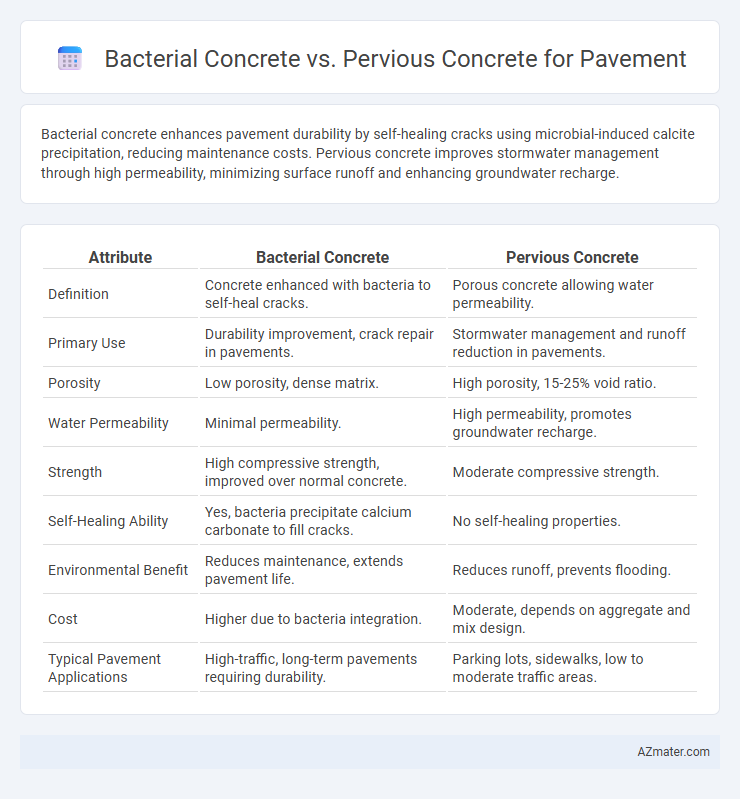Bacterial concrete enhances pavement durability by self-healing cracks using microbial-induced calcite precipitation, reducing maintenance costs. Pervious concrete improves stormwater management through high permeability, minimizing surface runoff and enhancing groundwater recharge.
Table of Comparison
| Attribute | Bacterial Concrete | Pervious Concrete |
|---|---|---|
| Definition | Concrete enhanced with bacteria to self-heal cracks. | Porous concrete allowing water permeability. |
| Primary Use | Durability improvement, crack repair in pavements. | Stormwater management and runoff reduction in pavements. |
| Porosity | Low porosity, dense matrix. | High porosity, 15-25% void ratio. |
| Water Permeability | Minimal permeability. | High permeability, promotes groundwater recharge. |
| Strength | High compressive strength, improved over normal concrete. | Moderate compressive strength. |
| Self-Healing Ability | Yes, bacteria precipitate calcium carbonate to fill cracks. | No self-healing properties. |
| Environmental Benefit | Reduces maintenance, extends pavement life. | Reduces runoff, prevents flooding. |
| Cost | Higher due to bacteria integration. | Moderate, depends on aggregate and mix design. |
| Typical Pavement Applications | High-traffic, long-term pavements requiring durability. | Parking lots, sidewalks, low to moderate traffic areas. |
Introduction to Bacterial and Pervious Concrete
Bacterial concrete incorporates specific microbial strains to precipitate calcium carbonate, enhancing self-healing properties and durability for pavement applications. Pervious concrete features a porous structure that promotes effective stormwater management by allowing water infiltration, reducing runoff and improving groundwater recharge. Both technologies address sustainability in pavement design, with bacterial concrete focusing on longevity and pervious concrete emphasizing environmental water control.
Composition and Mechanism of Bacterial Concrete
Bacterial concrete incorporates specific bacteria such as Bacillus pasteurii and nutrient sources like calcium lactate within the cement matrix to induce the biomineralization of calcium carbonate, enhancing self-healing and durability. Its mechanism relies on bacterial metabolic activity that precipitates calcite to seal cracks and pores, improving strength and reducing permeability. In contrast, pervious concrete primarily consists of coarse aggregates, cement, and minimal fine materials to create a porous structure that facilitates water infiltration but lacks active self-repair properties.
Composition and Mechanism of Pervious Concrete
Pervious concrete is composed of cement, coarse aggregates, little to no fine aggregates, and water, designed to create a porous structure that allows water infiltration, promoting stormwater management and reducing runoff. The mechanism of pervious concrete relies on interconnected voids, typically 15-35% porosity, facilitating rapid drainage while maintaining sufficient compressive strength for pavement applications. In contrast, bacterial concrete incorporates microbial-induced calcite precipitation to heal cracks and enhance durability, but it does not inherently provide permeability like pervious concrete.
Key Differences Between Bacterial and Pervious Concrete
Bacterial concrete incorporates specific microbial strains to induce calcite precipitation, enhancing self-healing and durability, while pervious concrete features a high porosity structure allowing water infiltration and improved stormwater management. The key difference lies in bacterial concrete's bio-mediated crack repair mechanism compared to pervious concrete's primary function of permeability and drainage. In pavement applications, bacterial concrete extends service life by autonomously repairing micro-cracks, whereas pervious concrete reduces surface runoff and mitigates urban flooding risks.
Durability Comparison in Pavement Applications
Bacterial concrete enhances pavement durability by self-healing micro-cracks through microbial-induced calcium carbonate precipitation, reducing permeability and extending service life. Pervious concrete offers excellent drainage and reduces hydrostatic pressure but typically exhibits lower compressive strength and is more prone to clogging, which can compromise its long-term durability. Comparative studies indicate bacterial concrete outperforms pervious concrete in resisting freeze-thaw cycles and chemical attacks, making it more suitable for high-traffic, durability-critical pavement applications.
Permeability and Drainage Capabilities
Bacterial concrete enhances permeability through microbially induced calcium carbonate precipitation, which seals micro-cracks while maintaining adequate drainage for pavement applications. Pervious concrete offers superior permeability by allowing water to flow directly through its interconnected pore structure, significantly improving surface drainage and reducing runoff. Comparing both, pervious concrete provides higher drainage efficiency, but bacterial concrete balances permeability with self-healing properties that improve long-term durability.
Sustainability and Environmental Impact
Bacterial concrete enhances sustainability by utilizing microbial-induced calcite precipitation to self-heal cracks, reducing maintenance frequency and extending pavement lifespan, thus lowering resource consumption. Pervious concrete promotes environmental benefits by allowing stormwater infiltration, mitigating urban runoff, and replenishing groundwater, which supports sustainable water management in pavements. While bacterial concrete minimizes environmental impact through durability and carbon footprint reduction, pervious concrete excels in managing water quality and reducing urban heat island effects.
Cost Analysis and Economic Viability
Bacterial concrete incorporates microbial-induced calcium carbonate precipitation, enhancing durability and self-healing properties but incurs higher initial costs due to specialized materials and processes. Pervious concrete offers cost-effective drainage solutions with lower material expenses and simpler installation, improving runoff management but requiring more frequent maintenance, impacting long-term economic viability. Evaluating lifecycle costs, bacterial concrete presents higher upfront investments offset by reduced repair needs, while pervious concrete provides immediate financial savings balanced against ongoing maintenance expenditures.
Performance in Diverse Climatic Conditions
Bacterial concrete enhances durability and self-healing in diverse climatic conditions by using microbial-induced calcite precipitation to seal cracks and reduce permeability, which improves resistance to freeze-thaw cycles and chemical attacks. Pervious concrete excels in stormwater management by allowing water infiltration, but its performance can decline in freezing climates due to ice formation in pores, leading to reduced strength and durability. Bacterial concrete offers superior structural longevity in extreme weather, whereas pervious concrete is optimal for temperate regions prioritizing drainage and filtration.
Conclusion: Choosing the Right Concrete for Pavement
Bacterial concrete enhances self-healing and durability by reducing micro-cracks through microbial activity, making it ideal for long-term pavement maintenance and sustainability. Pervious concrete excels in stormwater management and reducing surface runoff, offering superior environmental benefits for urban pavements requiring efficient drainage. Selecting the right concrete depends on prioritizing durability and maintenance savings with bacterial concrete or prioritizing permeability and environmental impact with pervious concrete.

Infographic: Bacterial concrete vs Pervious concrete for Pavement
 azmater.com
azmater.com